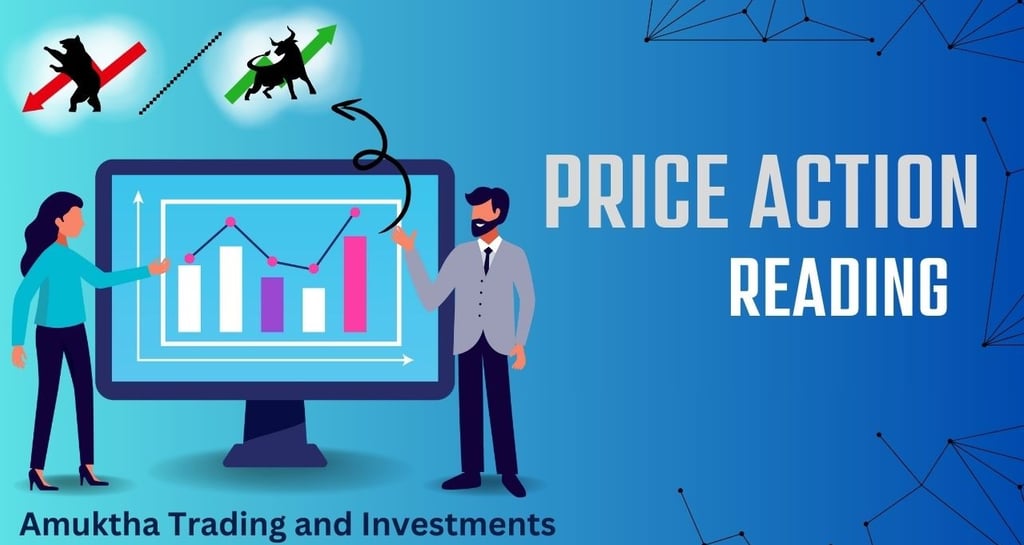

Price Action Trading — The Ultimate Guide for Traders Who Want Consistency
Price action trading is the backbone of every great trader’s toolkit. Unlike indicator-heavy systems that lag or clutter the screen, price action strips the market down to its purest signal — price itself. This article is an in-depth guide to price action trading that teaches you the meaning of price action trading, real-life setups, candlestick patterns, and a clear path to master this method. If you want personalized, one-on-one coaching to accelerate your learning and apply these techniques in real markets, message the mentor on WhatsApp: +91 7382177772.
What Is Price Action Trading?
Price action trading means making buy and sell decisions based on raw price movement — the highs, lows, opens and closes — and the structure they form over time. No lagging oscillators. No over-complicated signals. Just price telling you what the market participants actually did.
In short: price action is the language of the market. Reading it well reveals supply and demand, trader psychology, and the best places to enter or exit a trade.
Why beginners love it: price action focuses on context and structure rather than memorizing dozens of indicators. That makes it transferable across stocks, forex, and options.
Why Price Action Trading Is the Foundation of All Market Analysis
Every indicator is derived from price. Moving averages smooth raw prices, RSI quantifies price momentum, and MACD measures moving-average relationship. But those are all second-order representations.
When you learn price action:
You understand market structure: highs, lows, support, resistance, trendlines, and breakouts.
You read candlestick signals—which show short-term sentiment.
You develop the discipline to trade what the market is doing, not what an indicator hopes it might do.
That’s why many educators and pro traders — from Al Brooks to independent authors and publishers — recommend starting with pure price action before layering indicators. If you search for a price action trading course Al Brooks, you'll find that Al Brooks emphasizes reading bars and context — the same core principles we'll use here.
The Best Price Action Trading Books and Courses
Many resources exist; here’s a short list of high-value materials and courses to study:
Al Brooks — Known for bar-by-bar analysis; search for price action trading course al brooks to find his book series and course materials.
Price Action Trading Geek — A practical, community-driven resource that offers trade ideas and pattern breakdowns.
Price Action Trading Secrets Book — A beginner-friendly book that explains setups, risk management, and common pitfalls.
Price Action Traders Institute — Command Your Trading — Programs that focus on structure, psychology, and trade management (search for price action traders institute command your trading).
Price action trading best books — Look for books that emphasize context, not just patterns; cross-check reviews and sample chapters.
When choosing materials, prefer authors who teach structure + context (not just “pattern X = buy”). Good resources should include examples across timeframes and instruments.
Step-by-Step Guide: How to Learn Price Action Trading for Free
You don’t need to pay to learn the fundamentals. Here’s a free, structured path:
Start with the basics
Learn candlestick anatomy: open, high, low, close.
Understand trend: higher highs & higher lows (uptrend), lower highs & lower lows (downtrend).
Learn market structure
Identify swing highs/lows.
Draw support and resistance.
Practice on multiple timeframes.
Study common price action patterns
Inside bars, pin bars (rejecting wicks), engulfing bars, breakouts.
Combine patterns with structure (e.g., pin bar at resistance).
Backtest visually
Use a free charting platform (many brokers and TradingView have free tiers).
Scroll historical charts and mark setups you would have taken.
Journal every trade
Why you entered, your stop, target, outcome, and emotional state.
Paper trade or use a small live account
Keep position sizes tiny while you learn.
Engage with communities
Read free resources like price action trading geek posts and trading forums.
This is an in depth guide to price action trading in practice — lean on structured study, lots of chart time, and honest journaling. If you’d like a personalized learning roadmap or trade critiques, contact the mentor via WhatsApp at +91 7382177772.
Real-Life Price Action Trading Examples and Setups
Storytime: Meet Ravi — a part-time trader who lost money using 5 indicators. He switched to price action and followed this simple progression:
Recognized structure: He waited for clear trendlines and traded pullbacks only.
Spotting rejections: He learned to identify pin bars and engulfing candles at major levels.
Entry discipline: He entered on the break of the high (for bullish setups) with a stop below the rejection candle.
Risk management: He used fixed 1–2% risk per trade.
Within months, Ravi traded fewer setups but with higher confidence and better risk-reward.
Example setups to practice:
Trend pullback: Wait for market to make a clear trend. Enter when a small-range rejection candle forms at the trendline/support.
Range breakout: Trade a confirmed breakout with a retest of the breakout level (not on the immediate breakout exhaustion).
Pin bar at resistance: A long wick showing rejection at a resistance zone — consider a short with stop above wick.
These are classic price action trading examples used by many pros. The key is context: the same candlestick can mean different things in different locations.
Price Action Candlestick Patterns Explained
Candlestick patterns are shorthand for market psychology. Here are the most reliable ones when used with context:
Pin Bar (Hammer / Shooting Star): Long wick showing rejection. Stronger at major levels.
Inside Bar: Consolidation; useful for breakout or rejection setups depending on location.
Engulfing Bar: A full reversal candle that engulfs prior candles — shows momentum shift.
Doji: Indecision — powerful when at extremes or after a strong move.
Remember: Patterns alone are weak. Combine them with structure, volume context (when available), and risk management.
How to Master Price Action Trading in Stocks, Forex, and Options
Price action principles are universal, but you must adapt to each market’s characteristics.
Stocks
Watch for news events and daily gap behavior.
Trade with awareness of market hours and liquidity.
Forex
Fast-moving, around-the-clock market.
Pay attention to sessions (London, New York) and major levels.
Spread considerations are crucial.
Options
Price action guides directional hypothesis and entry timing, but options add decay and implied volatility.
Use price action to identify direction and then choose suitable option strikes and expiries.
General rules to apply across markets:
Trade higher timeframes for structural clarity.
Use smaller timeframes for precise entries.
Always consider liquidity and transaction costs.
Want tailored guidance specific to your market and account size? Reach out on WhatsApp for customized coaching: +91 7382177772.
Why Smart Traders Prefer Price Action Over Indicators
Indicators can be useful for confirmation — but they’re often:
Lagging: They react after price moves.
Noisy: Multiple indicators often give conflicting signals.
Overfitted: Systems tuned to past data rarely adapt.
Price action traders favor:
Simplicity — fewer moving parts.
Transparency — you see exactly why you entered.
Adaptability — price works across instruments and timeframes.
This explains why many successful traders and educators position price action as the core learning path. Searching for why price action trading is the best will return many testimonials and case studies from traders who improved after simplifying.
Price Action Trading Rules — A Practical Checklist
Use these rules as a baseline:
Trade with structure: only trade in the direction of the higher timeframe trend.
Prefer confluence: pattern + level + volume/structure.
Risk management first: position size for a small % of capital.
Wait for confirmation: retest after a breakout or a clean rejection candle.
Keep a journal: record decisions, context, and outcomes.
Continuously review: what worked, what didn’t, and why.
These price action trading rules form a discipline-focused approach that separates hobbyists from professionals.
FAQs About Price Action Trading
Q: What is the meaning of price action trading?
A: It’s trading based on the raw movement of prices — highs, lows, opens, and closes — and the structures they form.
Q: Can I learn price action trading for free?
A: Yes. Many resources help you learn price action trading for free. Follow a structured path: basics → structure → patterns → journal → practice.
Q: Which books should I read first?
A: Start with practical guides and then read deeper works like Al Brooks if you want bar-by-bar analysis. Search for price action trading best books and price action trading secrets book.
Q: Is price action trading suitable for options?
A: Yes — price action gives direction and timing. Combine with an understanding of options greeks and IV.
Q: What about automated indicators?
A: Indicators can help filter noise, but they shouldn't replace reading price context.
Q: Trading in Hindi: trading me price action kya hota hai?
A: Price action trading ka matlab hai market ke price moves ko samajhna aur unke aadhar par trade lena — indicators pe depend na karna. (Translation: Price action trading means understanding market price moves and trading based on them rather than relying on indicators.)
Final Story — From Confusion to Command
Imagine Sara, who spent months toggling indicators and felt paralyzed by conflicting signals. When she switched to price action, she could instantly see where institutional orders were likely placed (support/resistance zones), and where momentum was running out (long rejection wicks). She stopped trading during noisy consolidations, reduced her trade count, and improved her confidence. Not because she found a magic formula, but because she learned to command the market — one setup at a time.
If you want that kind of accelerated learning with real-time feedback, step-by-step mentoring, and trade review sessions, the mentor is ready to help. Message on WhatsApp: +91 7382177772 for personalized one-on-one coaching.
Closing — Why Mastering Price Action Matters
Price action trading gives you a durable foundation. It teaches structure, context, and discipline — the three things that determine long-term success. Whether you’re searching for an in depth guide to price action trading or looking for the price action trading course Al Brooks style of training, start with small steps: read bars, trade with rules, and maintain humility.
If you’re serious about moving from confusion to consistent execution, personalized coaching can shorten the learning curve dramatically. For one-on-one mentorship tailored to your goals (stocks, forex, or options), reach out on WhatsApp at +91 7382177772 — get feedback on your charts, a customized learning plan, and real accountability.
Trade smart. Read price. Command your trading.
Disclaimer:- Trading and Investments in the securities market are subject to market risk, and read all the related documents carefully before investing. The content is for informational purposes only and should not be construed as investment advice. Always consult with a qualified financial professional before making any trading decisions.
